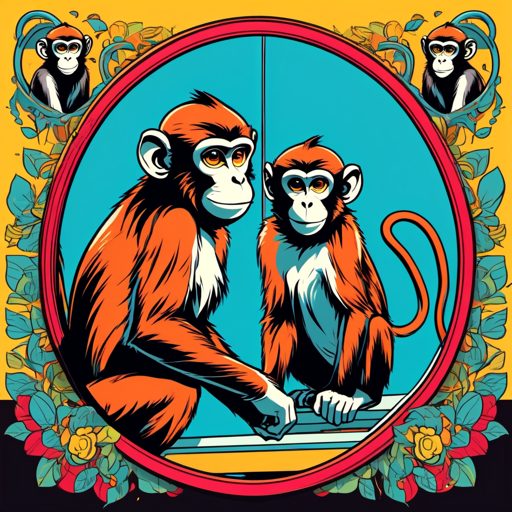
Smartest Animals Identify Themselves in Mirrors!
Recommended for Preparatory Grades
Our understanding of the animal kingdom is ever-evolving, especially regarding cognitive abilities. One of the benchmarks for animal intelligence has been the “mirror test,” designed to assess whether an animal can recognize its own reflection. This test has opened up a fascinating window into the minds of some of the “smartest animals” on Earth, revealing unexpected insights into animal self-awareness.
Listen to the news
Key Facts
- The mirror test began in 1970 to evaluate animal self-recognition.
- This test was a groundbreaking approach to understanding if animals could identify themselves in a mirror.
- Researchers anesthetized chimpanzees and applied red dye to their faces to see if they would recognize the marks upon waking.
- Only a few species have passed the mirror test since its inception.
- The list includes certain primates, elephants, dolphins, and some bird species.
- Many animals fail to show any signs of self-recognition, treating their reflection as another animal or showing indifference.
- Animals tested range from small insects to large mammals and even include birds.
- The diversity of species examined underscores the complexity and varied nature of animal consciousness.
- Some species, like ants and manta rays, have shown behaviors that suggest a form of self-recognition, albeit controversially.
- Chimpanzees were among the first to pass the test in 1970.
- Their ability to recognize the dye and touch it while looking in the mirror was a significant indicator of self-recognition.
- These findings were pivotal in reinforcing the view that chimps share cognitive abilities with humans.
- Great apes like orangutans and bonobos have also recognized themselves in mirrors.
- Orangutans, in a 1973 study, displayed self-directed behaviors when they saw marks on their bodies in a mirror.
- Bonobos used mirrors to inspect parts of their bodies that were otherwise not visible, suggesting a higher level of self-awareness.
Reflective Recognition
- Results for gorillas and monkeys have been inconclusive or required training.
- Gorillas have had mixed results, with some individuals passing the test while others failed.
- Monkeys generally do not pass the mirror test without extensive training, casting doubt on their natural level of self-awareness.
- Training animals for the test raises questions about whether the resulting behavior truly reflects self-awareness or just learned responses.
- Training, as critics argue, might not be indicative of inherent self-awareness but rather the ability to learn and adapt to tasks.
- The implication of training in the context of the mirror test has stirred debate about the very nature of self-awareness in animals.
- The Asian elephant, certain dolphins, Eurasian magpies, and even pigeons (with training) have passed the mirror test.
- An Asian elephant at the Bronx Zoo was observed touching a white “X” on its forehead while looking in a mirror, suggesting recognition.
- Dolphins have demonstrated self-directed behaviors in response to their reflections, and Eurasian magpies have passed the test without training, unlike pigeons.
- Controversy exists over lower-order animals like ants and fish potentially passing the test.
- Ants removing blue paint from their heads when confronted with a mirror sparked debates about what constitutes self-awareness.
- Cleaner wrasses and manta rays have shown behaviors that could be interpreted as self-recognition, but without the rigorous methodology of the mark test, these findings remain debatable.
Final Thoughts
These facts do underscore the complexity of animal cognition and the challenges of interpreting behaviors as signs of self-awareness. The mirror test, while not flawless, continues to be a valuable tool in the quest to understand the mental lives of animals, pushing the boundaries of what we consider the “smartest animals” and broadening our appreciation of intelligence in the natural world.
Similar Stories
Watch a video
Check out a virtual safari tour at the Werribee Open Range Zoo in Australia.
Curious Times is a leading newspaper and website for kids. We publish daily global news aligned to your learning levels (also as per NEP 2020): Foundational, Preparatory (Primary), Middle and Senior. So, check out the News tab for this. We bring kids’ favourite Curious Times Weekly newspaper every weekend with top news, feature stories and kids’ contributions. Also, check out daily JokesPoke, Tongue Twisters, Word of the Day and Quote of the Day, kids need it all the time.
Curious Times News Program for Schools for FREE. Over 5,000 schools and teachers from all over the world have joined our programme so that students and teachers can get FREE Educative Newspaper. Here, kids can take part in world events and win prizes and certificates for free through their schools.
Moreover, schools are sharing important School News, like interviews with the principal, notices about new students, contests, and results, not just on social media but also on a news website for kids and other schools.
Thus, do not wait any further, sign-up for your school for FREE.
The following social media platforms allow you to communicate with us: WhatsApp, Instagram, Facebook, Youtube, Twitter, and LinkedIn.
0 (Please login to give a Curious Clap to your friend.)
